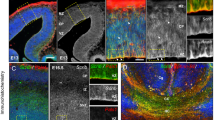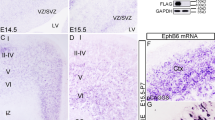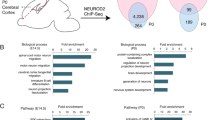Abstract
Disorders of neuronal migration can lead to malformations of the cerebral neocortex that greatly increase the risk of seizures. It remains untested whether malformations caused by disorders in neuronal migration can be reduced by reactivating cellular migration and whether such repair can decrease seizure risk. Here we show, in a rat model of subcortical band heterotopia (SBH) generated by in utero RNA interference of the Dcx gene, that aberrantly positioned neurons can be stimulated to migrate by reexpressing Dcx after birth. Restarting migration in this way both reduces neocortical malformations and restores neuronal patterning. We further find that the capacity to reduce SBH continues into early postnatal development. Moreover, intervention after birth reduces the convulsant-induced seizure threshold to a level similar to that in malformation-free controls. These results suggest that disorders of neuronal migration may be eventually treatable by reengaging developmental programs both to reduce the size of cortical malformations and to reduce seizure risk.
This is a preview of subscription content, access via your institution
Access options
Subscribe to this journal
Receive 12 print issues and online access
$209.00 per year
only $17.42 per issue
Buy this article
- Purchase on Springer Link
- Instant access to full article PDF
Prices may be subject to local taxes which are calculated during checkout






Similar content being viewed by others
Change history
07 November 2011
In the version of this article initially published, the labels in the key to the bar graph in Figure 2c were incorrect. The gray bars should have been labeled 'Double cortex', and the white bars should have been 'P0 rescue'. The error has been corrected in the HTML and PDF versions of the article.
References
Jacobs, K.M., Kharazia, V.N. & Prince, D.A. Mechanisms underlying epileptogenesis in cortical malformations. Epilepsy Res. 36, 165–188 (1999).
Chevassus-au-Louis, N., Baraban, S.C., Gaïarsa, J.L. & Ben-Ari, Y. Cortical malformations and epilepsy: new insights from animal models. Epilepsia 40, 811–821 (1999).
Schwartzkroin, P.A. & Walsh, C.A. Cortical malformations and epilepsy. Ment. Retard. Dev. Disabil. Res. Rev. 6, 268–280 (2000).
Kuzniecky, R.I. & Barkovich, A.J. Malformations of cortical development and epilepsy. Brain Dev. 23, 2–11 (2001).
Sisodiya, S.M. Malformations of cortical development: burdens and insights from important causes of human epilepsy. Lancet Neurol. 3, 29–38 (2004).
Sisodiya, S.M. Surgery for malformations of cortical development causing epilepsy. Brain 123, 1075–1091 (2000).
Guerrini, R. Genetic malformations of the cerebral cortex and epilepsy. Epilepsia 46 Suppl 1, 32–37 (2005).
Barkovich, A.J., Jackson, D.E.J. & Boyer, R.S. Band heterotopias: a newly recognized neuronal migration anomaly. Radiology 171, 455–458 (1989).
Dobyns, W.B. et al. X-linked malformations of neuronal migration. Neurology 47, 331–339 (1996).
Bernasconi, A. et al. Surgical resection for intractable epilepsy in double cortex syndrome yields inadequate results. Epilepsia 42, 1124–1129 (2001).
Barkovich, A.J. et al. Band heterotopia: correlation of outcome with magnetic resonance imaging parameters. Ann. Neurol. 36, 609–617 (1994).
Guerrini, R. & Carrozzo, R. Epilepsy and genetic malformations of the cerebral cortex. Am. J. Med. Genet. 106, 160–173 (2001).
Pinard, J.M. et al. Subcortical laminar heterotopia and lissencephaly in two families: a single X linked dominant gene. J. Neurol. Neurosurg. Psychiatry 57, 914–920 (1994).
des Portes, V. et al. Doublecortin is the major gene causing X-linked subcortical laminar heterotopia (SCLH). Hum. Mol. Genet. 7, 1063–1070 (1998).
Gleeson, J.G. et al. Doublecortin, a brain-specific gene mutated in human X-linked lissencephaly and double cortex syndrome, encodes a putative signaling protein. Cell 92, 63–72 (1998).
Matsumoto, N. et al. Mutation analysis of the DCX gene and genotype/phenotype correlation in subcortical band heterotopia. Eur. J. Hum. Genet. 9, 5–12 (2001).
D'Agostino, M.D. et al. Subcortical band heterotopia (SBH) in males: clinical, imaging and genetic findings in comparison with females. Brain 125, 2507–2522 (2002).
Lee, K.S. et al. A genetic animal model of human neocortical heterotopia associated with seizures. J. Neurosci. 17, 6236–6242 (1997).
Chevassus-Au-Louis, N., Rafiki, A., Jorquera, I., Ben-Ari, Y. & Represa, A. Neocortex in the hippocampus: an anatomical and functional study of CA1 heterotopias after prenatal treatment with methylazoxymethanol in rats. J. Comp. Neurol. 394, 520–536 (1998).
Baraban, S.C. & Schwartzkroin, P.A. Flurothyl seizure susceptibility in rats following prenatal methylazoxymethanol treatment. Epilepsy Res. 23, 189–194 (1996).
Baraban, S.C., McCarthy, E.B. & Schwartzkroin, P.A. Evidence for increased seizure susceptibility in rats exposed to cocaine in utero. Brain Res. Dev. Brain Res. 102, 189–196 (1997).
Roper, S.N., Gilmore, R.L. & Houser, C.R. Experimentally induced disorders of neuronal migration produce an increased propensity for electrographic seizures in rats. Epilepsy Res. 21, 205–219 (1995).
Jacobs, K.M., Gutnick, M.J. & Prince, D.A. Hyperexcitability in a model of cortical maldevelopment. Cereb. Cortex 6, 514–523 (1996).
Luhmann, H.J. & Raabe, K. Characterization of neuronal migration disorders in neocortical structures: I. Expression of epileptiform activity in an animal model. Epilepsy Res. 26, 67–74 (1996).
Nosten-Bertrand, M. et al. Epilepsy in Dcx knockout mice associated with discrete lamination defects and enhanced excitability in the hippocampus. PLoS ONE 3, e2473 (2008).
Bai, J. et al. RNAi reveals doublecortin is required for radial migration in rat neocortex. Nat. Neurosci. 6, 1277–1283 (2003).
Ramos, R.L., Bai, J. & LoTurco, J.J. Heterotopia formation in rat but not mouse neocortex after RNA interference knockdown of DCX. Cereb. Cortex 16, 1323–1331 (2006).
Matsuda, T. & Cepko, C.L. Controlled expression of transgenes introduced by in vivo electroporation. Proc. Natl. Acad. Sci. USA 104, 1027–1032 (2007).
Lim, D.A., Huang, Y. & Alvarez-Buylla, A. The adult neural stem cell niche: lessons for future neural cell replacement strategies. Neurosurg. Clin. N. Am. 18, 81–92 ix (2007).
Imitola, J. et al. Directed migration of neural stem cells to sites of CNS injury by the stromal cell-derived factor 1α/CXC chemokine receptor 4 pathway. Proc. Natl. Acad. Sci. USA 101, 18117–18122 (2004).
Rakic, P. Mode of cell migration to the superficial layers of fetal monkey neocortex. J. Comp. Neurol. 145, 61–83 (1972).
Stichel, C.C., Muller, C.M. & Zilles, K. Distribution of glial fibrillary acidic protein and vimentin immunoreactivity during rat visual cortex development. J. Neurocytol. 20, 97–108 (1991).
Kalman, M. & Ajtai, B.M. A comparison of intermediate filament markers for presumptive astroglia in the developing rat neocortex: immunostaining against nestin reveals more detail, than GFAP or vimentin. Int. J. Dev. Neurosci. 19, 101–108 (2001).
Guerrini, R., Canapicchi, R. & Dobyns, W.B. Epilepsy and malformations of the cerebral cortex. Neurologia 14 Suppl 3, 32–47 (1999).
Baraban, S.C. Epileptogenesis in the dysplastic brain: a revival of familiar themes. Epilepsy Curr. 1, 6–11 (2001).
Sheen, V.L. & Walsh, C.A. Developmental genetic malformations of the cerebral cortex. Curr. Neurol. Neurosci. Rep. 3, 433–441 (2003).
Crino, P.B. Malformations of cortical development: molecular pathogenesis and experimental strategies. Adv. Exp. Med. Biol. 548, 175–191 (2004).
Cepeda, C. et al. Pediatric cortical dysplasia: correlations between neuroimaging, electrophysiology and location of cytomegalic neurons and balloon cells and glutamate/GABA synaptic circuits. Dev. Neurosci. 27, 59–76 (2005).
Chae, T. et al. Mice lacking p35, a neuronal specific activator of Cdk5, display cortical lamination defects, seizures and adult lethality. Neuron 18, 29–42 (1997).
Hablitz, J.J. & DeFazio, T. Excitability changes in freeze-induced neocortical microgyria. Epilepsy Res. 32, 75–82 (1998).
Andres, M. et al. Human cortical dysplasia and epilepsy: an ontogenetic hypothesis based on volumetric MRI and NeuN neuronal density and size measurements. Cereb. Cortex 15, 194–210 (2005).
Corbo, J.C. et al. Doublecortin is required in mice for lamination of the hippocampus but not the neocortex. J. Neurosci. 22, 7548–7557 (2002).
Koizumi, H., Tanaka, T. & Gleeson, J.G. Doublecortin-like kinase functions with doublecortin to mediate fiber tract decussation and neuronal migration. Neuron 49, 55–66 (2006).
Coquelle, F.M. et al. Common and divergent roles for members of the mouse DCX superfamily. Cell Cycle 5, 976–983 (2006).
Racine, R.J. Modification of seizure activity by electrical stimulation. I. After-discharge threshold. Electroencephalogr. Clin. Neurophysiol. 32, 269–279 (1972).
Paxinos, G. & Watson, C. The Rat Brain in Stereotaxic Coordinates (Elsevier Academic Press, Oxford, 2005).
Acknowledgements
CALNL-eGFP and CAG-ERT2CreERT2 were gifts from T. Matsuda and C. Cepko, Harvard Medical School. ImageJ software was from W. Rasband, US National Institutes of Health. NeuronJ 1.2 was from E. Meijering (Erasmus University Medical Center Rotterdam). This work was supported by the US National Institutes of Health (MH056524 and NS062416 to J.J.L.) and the Jerome Lejeune foundation (research fellowship to J.-B.M.).
Author information
Authors and Affiliations
Contributions
J.-B.M. and J.J.L. contributed to all aspects of the project; J.-B.M. conducted histological procedures, seizure induction experiments, quantifications and data analysis; Y.W. performed intrauterine surgeries and interneuron analysis; Y.C. performed confocal microscopy, interneuron analysis and contributed to seizure induction experiments and M.P. constructed the plasmid vectors and contributed to confocal microscopy.
Corresponding author
Supplementary information
Supplementary Text and Figures
Supplementary Figs. 1–4 (PDF 1746 kb)
Rights and permissions
About this article
Cite this article
Manent, JB., Wang, Y., Chang, Y. et al. Dcx reexpression reduces subcortical band heterotopia and seizure threshold in an animal model of neuronal migration disorder. Nat Med 15, 84–90 (2009). https://doi.org/10.1038/nm.1897
Received:
Accepted:
Published:
Issue Date:
DOI: https://doi.org/10.1038/nm.1897
This article is cited by
-
Increased prevalence of minor physical anomalies in patients with epilepsy
Scientific Reports (2022)
-
Wwox deficiency leads to neurodevelopmental and degenerative neuropathies and glycogen synthase kinase 3β-mediated epileptic seizure activity in mice
Acta Neuropathologica Communications (2020)
-
Cell migration promotes dynamic cellular interactions to control cerebral cortex morphogenesis
Nature Reviews Neuroscience (2019)
-
Two-photon probes for in vivo multicolor microscopy of the structure and signals of brain cells
Brain Structure and Function (2018)
-
Variations in brain defects result from cellular mosaicism in the activation of heat shock signalling
Nature Communications (2017)



